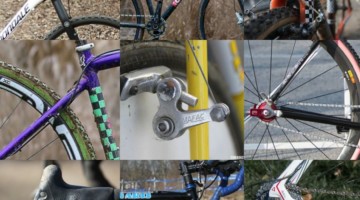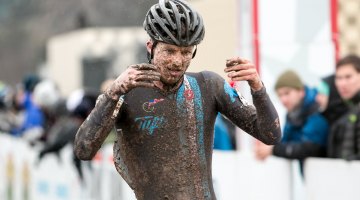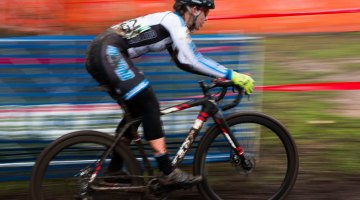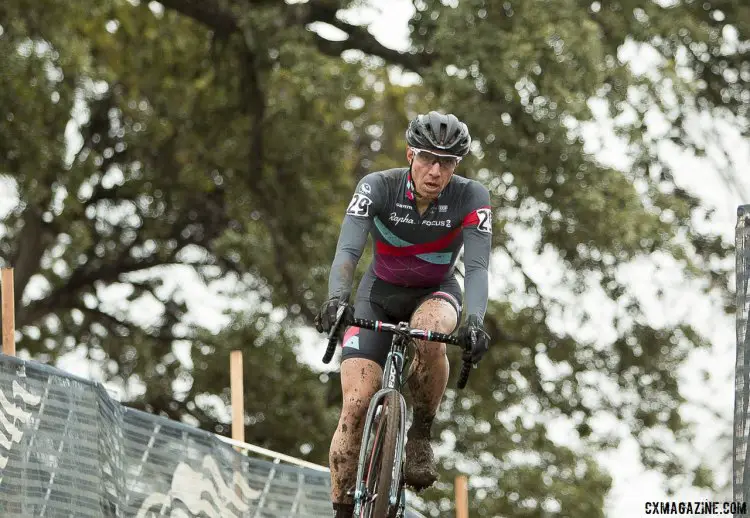
Jeremy Powers (Aspire) plays it cool in the shade of Zilker’s Heritage Tree – 2015 Cyclocross National Championships © Cyclocross Magazine
The day after the USA Cycling 2015 Cyclocross National Championships wrapped up, it’d be easy to play Monday Tuesday Morning Quarterback and analyze who is to blame for the Nationals disaster. Frankly, everyone from the city of Austin, Austin’s Heritage Tree Foundation, USA Cycling, Cadence Sports (event promoter) and the course designers all certainly could have done something differently to help avoid the calamity of the Postponed Nationals.
Feigning ignorance or citing lack of communication isn’t a good excuse. Sure, better communication could have prevented the last-minute protest, cancellation and postponement, but one could also argue that it’s a race promoter, course designer and governing body’s responsibility to know what the best practices are in terms of building a course in a manner that leaves the area in as good a condition, if not better, than before cyclocross racing.
That’s different than building a course to avoid vocal interest groups from getting upset. Hopefully by doing the former you also accomplish the latter.
We’re lucky enough to race in a lot of scenic parks, many with trees a good number of years older than us. The trees make for more scenic courses, more interesting terrain, less overheated racers in early season races, and even better photos.
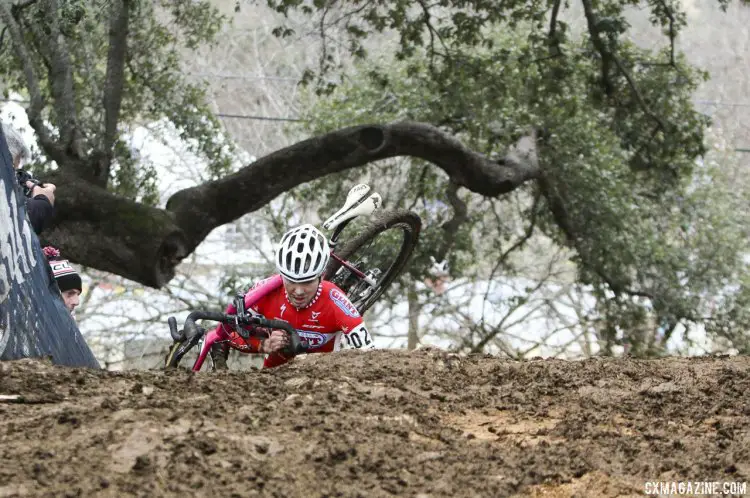
Logan Owen runs three flights of stairs to his 10th title – but the Zilker trees still soar above him. © Cyclocross Magazine
Should we build courses just to avoid protests and complaints? If Sunday’s racing happened without a hitch, but we find out much later that the ancient trees suffered or died, that would not be a success by any means, and not healthy for the long-term interest of our sport.
Some, including us, have attempted to see some humor in the events. But for everyone impacted, it’s more than a laughing matter. It was incredibly expensive, disruptive, potentially impacted titles, and prevented many Austinites from getting exposed to the sport.
Everyone has an opinion on why it happened, who is to blame, and how we avoid this going forward. Arborists have chimed in, cyclocrossers have chimed in, but how about a cyclocrossing arborist?
Certified arborist Chris Rippey wanted to offer his perspective and opinion due to his unique expertise with both trees and cyclocross racing and ability to see both sides of the course tape. His opinion should be relevant to not only National-level event promoters, but local grass roots cyclocross promoters and course designers as well.
See his op-ed, written yesterday, below, and feel free to share your thoughts in a comment.
by Chris Rippey
I want to give an Arborist’s perspective on the decision to postpone the 2015 Cyclocross Nationals Championships at Zilker Park in Austin, TX.
I am a Certified Arborist employed with Stanford University. I have been a professional arborist for 16 years. I have also been racing cyclocross since 2010. I feel bad for what seems to be an easily-avoidable situation that screwed over so many people. I want to shed some light on the science of compacting roots so we don’t think this was in vain.
First off, I am not in Austin. I have not seen the course nor the trees firsthand beyond photographs so I will try my best not to talk about things that I do not know. I have seen one solid picture of compacted soil under what appears to be an oak tree over 24 inches in diameter at breast height, which would qualify it as a Heritage Tree under Austin City Code.
I have heard reports and seen in photos that there were several other trees like this one on or near the course. The race was stopped after four days into the event because of potential damage to the tree roots via soil compaction from bikes being ridden over them in combination with soil saturation from the rain.
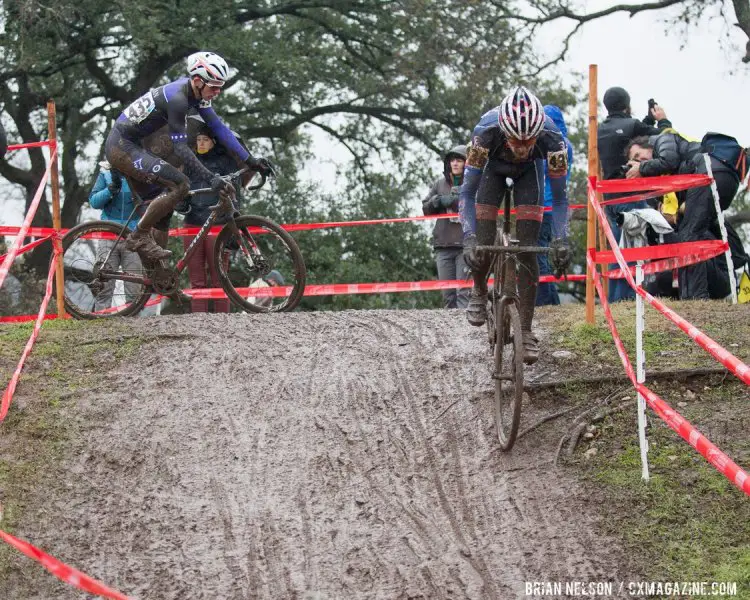
Brendan Rhim (Fuhrman University) and Robert Rimmer (King University) navigate the tree roots and muddy descent. © Brian Nelson
I protect trees for a living and hobby. Protecting a tree’s root integrity is very high on the list of things to protect. Tree roots extend beyond the canopy line, so in a perfect world one would like to protect 1.5 times the canopy area to best protect a tree root system. Generally, we compromise with clients to attain total protection for the area under a tree’s drip line (imagine water running off the edges of a tree’s canopy like an umbrella). The drip line is where rain water is most available to the tree. Feeder roots are found throughout the drip line.
These sensitive roots are near the top of the soil where they can easily get the water and nutrients. They are not the big roots that you typically think of. When you compact a soil you can kill these roots or make that soil unusable to the tree. If the roots are killed or they cannot function properly, the tree can experience loss of growth, spread of decay in the root system, canopy die back or total death. It typically takes five years for a tree to fully regain growth rates following root system damage. This is what was happening at Zilker Park to some varying degree and that is why the Heritage Tree community there is in such upheaval.
Why did this get so far?
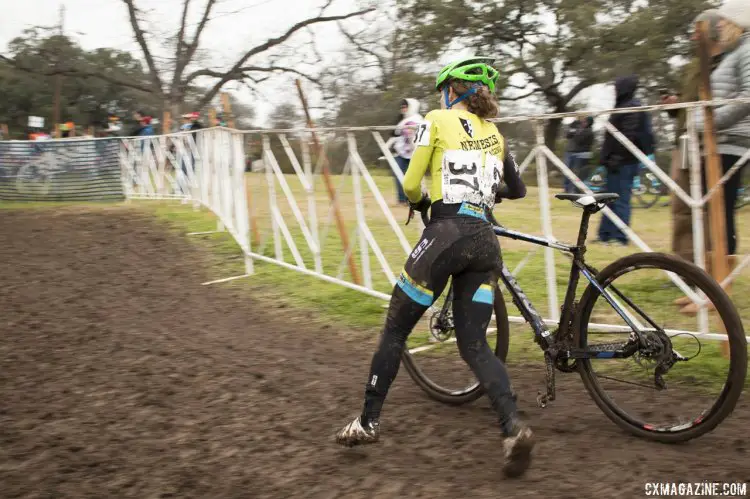
Andi Zolton (Nemesis Racing) runs the muddy track, past several prominent Heritage trees on the frontside of the course – 2015 Cyclocross National Championships © Cyclocross Magazine
ANSI Standards A300 is our best management practices for Arboriculture. They state that you should not allow, without concern, this type of impact. It doesn’t state anything about weather. The rain argument is a moot point. This race course, per the best management of these “Heritage Trees,” should not have happened regardless of rain or shine. This should have been hammered out in planning by a competent arborist.
It doesn’t state anything about weather.
As a cyclocross racer, I have pointed out tree concerns in our local races and course promoters have very happily modified their course accoringly. I feel the cyclocross community has a good respect for nature. Would you want to be racing on a course that could be doing significant damage to a 100+-year-old being? Or racing cyclocross or mountain bikes in a treeless field? I wouldn’t.
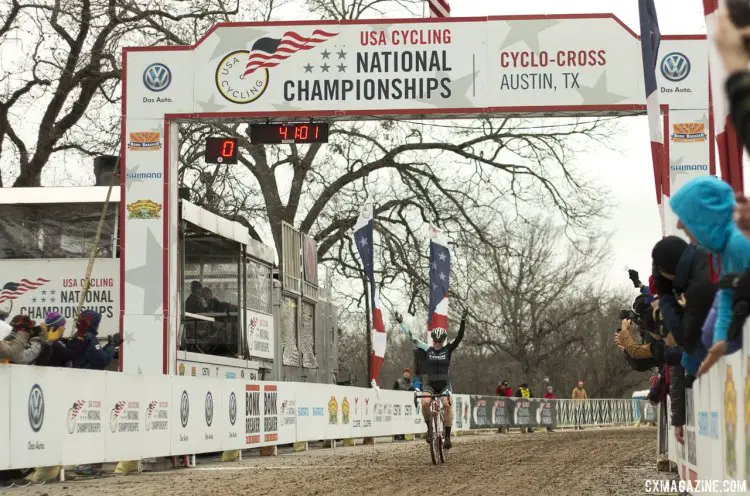
Katie Compton (Trek Factory Racing) wins her 11th title underneath a row of Heritage Trees at Zilker Park – 2015 Cyclocross National Championships © Cyclocross Magazine
I hope this was helpful and educational for cyclocrossers, race promoters, and tree lovers. I feel bad for everyone’s frustrations, expenses, and national championship title implications, but I hope this can be a learning moment.
I offer my service, free of charge, to any NorCal race promoter (and Nevada – think Reno 2018). Drop a comment below if you’d like to contact me.
Chris Rippey, Certified Arborist/Cyclocross Racer























